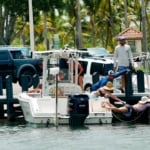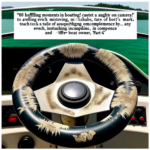So you’re out on a peaceful day of boating when suddenly you spot a vessel in distress. What do you do? As a responsible boater, it’s crucial to know the protocol for assisting other boats in distress, as your actions can make a significant difference in potentially saving lives. From contacting the Coast Guard to offering necessary aid, this article will provide you with insights on how to handle such situations with confidence and ensure the safety of your fellow seafarers.
Understanding the Importance of Assisting Boats in Distress
As a responsible boater, it is crucial for you to understand the importance of assisting boats in distress. By being aware of the potential risks and dangers of ignoring distress signals, you can ensure the safety and well-being of your fellow boaters.
The Responsibility of Boaters Towards Each Other
Boaters have a duty to help each other when they encounter a boat in distress. This responsibility is not only a moral one, but it is also mandated by national and international maritime laws. When you are out on the water, you are part of a community, and it is vital to act as a supportive and helpful member of that community.
The Potential Risks and Dangers of Ignoring Distress Signals
Ignoring distress signals can have grave consequences for those in need. By neglecting to assist a boat in distress, you are potentially putting the lives of others at risk. Incidents such as engine failures, fires, or taking on water can quickly escalate if not addressed promptly. Additionally, lack of assistance can lead to prolonged exposure to dangerous weather conditions or other life-threatening situations. It is essential to recognize the potential risks and understand the impact of your actions or inactions.
Recognizing Boats in Distress
Being able to recognize the signs of a boat in distress is crucial to providing timely assistance. Look out for common indications that a vessel is in trouble, such as distress signals, flags, or flashing lights. Additionally, observe the behavior of the boat and its occupants. Uneven or erratic movements, unusual sounds, or distress calls over the radio are all potential signs of trouble.
Proper Observation and Communication Techniques
Once you have identified a boat in distress, it is essential to maintain proper observation and communication techniques. Use binoculars or other visual aids to get a better view of the situation without putting yourself at risk. If possible, establish a line of communication with the distressed boat by radio or other means, allowing you to gather vital information and offer assistance.
Contacting the Distressed Boat
Establishing communication channels with the distressed boat is crucial to assess the situation effectively and provide appropriate assistance. Use your radio or other communication devices to establish contact. When communicating, remain calm and clear, ensuring that both parties understand each other’s messages. If the distressed boat does not have a radio, refer to visual signals or other means of communication to establish contact.
Using Appropriate Communication Devices
When contacting a distressed boat, it is essential to use appropriate communication devices. A VHF radio is the most common and widely accepted means of communication for boaters. Ensure that your radio is in good working condition and that you are familiar with its operation. Additionally, consider having back-up communication devices such as flares, a whistle, or a signaling mirror, especially if you are in an area with limited radio coverage.
Maintaining a Calm and Clear Line of Communication
During the communication process, it is crucial to maintain a calm and clear line of communication with the distressed boat. Keep your communication concise and avoid unnecessary chatter or confusion. Listen carefully to the distressed party’s needs and concerns and provide clear instructions or assistance based on the information you receive.
Assessing the Situation
Once you have established communication with the distressed boat, it is time to assess the situation in detail. Gather as much information as possible to understand the nature and severity of the distress. Ask questions about the boat’s current condition, the number of people on board, and any immediate dangers they may be facing. This information will help you determine the urgency of the distress and the appropriate course of action.
Gathering Information from the Distressed Boat
Speak to the distressed boat’s occupants and gather detailed information about their situation. Inquire about their exact location, the nature of the problem they are experiencing, and any specific needs or concerns. Understanding the specifics of the distress will allow you to provide more effective assistance and, if necessary, communicate the relevant information to the authorities.
Identifying Safety Hazards or Potential Risks
As you assess the distress situation, be diligent in identifying any safety hazards or potential risks that may exist. Look for signs of fire, leaking fuel, or taking on water. Determine if there are any immediate dangers that could threaten the safety of the distressed individuals or your own safety during the rescue operation. It is important to address these risks as swiftly as possible to prevent further escalation of the situation.
Determining the Urgency of the Distress
Based on the information gathered, determine the urgency of the distress. Evaluate the severity of the situation, taking into account factors such as the boat’s condition, the number of individuals on board, and any immediate dangers they are facing. If the distress is life-threatening or the boat is in imminent danger, it is critical to act quickly and provide immediate assistance.
Providing Initial Assistance
Once you have assessed the distress situation, it is time to provide initial assistance to stabilize the situation. Offer guidance and instructions to the distressed boat’s occupants on actions they can take to mitigate the problem. This may include steps to control a fire, secure a damaged vessel, or address any other immediate concerns. If there are individuals on board who require immediate medical aid, provide the necessary assistance until professional medical help arrives.
Stabilizing the Situation
Depending on the nature of the distress, it may be necessary to stabilize the situation before proceeding with further assistance or rescue operations. This could involve actions such as stopping a boat from taking on water, preventing further damage to a disabled vessel, or extinguishing a fire. Stabilizing the situation is vital to ensure the safety of the distressed individuals and create a safer environment for the rescue operation.
Offering Immediate Medical Aid If Necessary
If there are individuals on the distressed boat who require immediate medical aid, be prepared to offer necessary assistance. This could include providing CPR, administering basic first aid, or using any medical equipment you may have on board. Ensure that you have the knowledge and training to provide such aid safely and effectively. Remember to prioritize your own safety while rendering assistance.
Notifying the Authorities
In situations where the distress requires professional assistance or a large-scale rescue operation, it is crucial to notify the authorities. Contact the Coast Guard or local authorities, providing them with accurate information about the distress situation. Be prepared to provide details such as the distressed boat’s location, the number of people on board, and the nature of the problem they are facing. Timely notification of the authorities will expedite the response and ensure that appropriate resources are deployed.
Contacting the Coast Guard or Local Authorities
When contacting the authorities, make sure to have the relevant contact information readily available. This may include the Coast Guard’s emergency line, the local maritime law enforcement agency, or any other appropriate emergency services. Inform the authorities about the distress situation with clarity and precision, as this will aid them in assessing the level of response required.
Providing Accurate Information About the Distress
When notifying the authorities, accuracy and detail in conveying information are critical. Provide precise information about the distressed boat’s situation, including its exact location, the number of individuals on board, and the nature of the problem they are facing. If possible, offer any additional information that may assist in the rescue operation, such as specific hazards or challenging environmental conditions.
Preparing for a Rescue Operation
In some distress situations, additional assistance or resources may be required to carry out a successful rescue operation. Evaluate the need for such assistance based on the severity of the distress and the resources available to you. If other boats are nearby, coordinate with their captains or crew to pool resources and enhance the chances of a successful rescue operation.
Determining the Need for Additional Assistance
Assess the distress situation carefully to determine if additional assistance is required. Consider factors such as the size and condition of the distressed boat, the number of people on board, the weather conditions, and the complexity of the rescue operation. If it becomes evident that you do not have the necessary resources or expertise to handle the situation alone, seek assistance from other nearby boaters or notify the authorities to coordinate a larger-scale rescue effort.
Coordinating with Other Nearby Boats If Available
If other boats are within proximity, coordinating with their captains or crew can significantly enhance the effectiveness of a rescue operation. Establish clear communication channels and share relevant information about the distress situation. Coordinate efforts to pool resources, equipment, and manpower. By working together, you can improve the chances of a safe and successful rescue.
Executing a Rescue Operation
Executing a rescue operation requires careful planning, attention to safety, and precision in action. Assess the risks involved and plan the operation accordingly. Ensure the safety of both the rescuers and the distressed individuals throughout the process. Execute the rescue operation with caution, adhering to the plan and adapting as necessary to overcome challenges that may arise.
Assessing the Risks and Planning the Operation
Before initiating a rescue operation, assess the risks involved and plan accordingly. Consider factors such as weather conditions, sea state, visibility, and the nature of the distress. Develop a strategy that maximizes safety for all involved while addressing the specific challenges of the situation. Communicate the plan clearly to all participants before commencing the rescue operation.
Ensuring Safety of Both the Rescuers and the Distressed Individuals
Safety should always be the top priority during a rescue operation. Take necessary precautions to ensure the safety of both the rescuers and the distressed individuals. Equip everyone involved with appropriate personal protective equipment, and maintain clear lines of communication throughout the operation. Regularly reassess the risks and adjust the operation as required to minimize potential hazards.
Executing the Rescue Operation with Caution and Precision
When executing a rescue operation, proceed with caution and precision. Follow the established plan, communicate clearly, and coordinate actions to ensure a smooth operation. Stay vigilant for changing conditions or unexpected developments. Be prepared to make quick decisions and adapt the rescue strategy as necessary to ensure the safety and success of the operation.
Providing Post-Rescue Support
After successfully rescuing the distressed individuals, it is crucial to provide post-rescue support. Attend to their immediate needs and check their physical and emotional well-being. Offer necessary medical aid and comfort, ensuring that any injuries or discomfort are addressed appropriately. Provide assistance in arranging transportation or further help if required.
Checking the Condition of the Rescued Individuals
Upon completing the rescue, carefully assess the condition of the rescued individuals. Check for any injuries, signs of shock, or immediate medical concerns. Take the necessary steps to address their physical well-being and provide comfort as needed. Be prepared to administer first aid or call for professional medical assistance if the situation requires it.
Offering Necessary Medical Aid and Comfort
Addressing the medical needs of the rescued individuals is a crucial part of post-rescue support. Provide necessary medical aid, taking into consideration any injuries or conditions you may have identified. Keep them calm and comfortable, offering reassurance and support during this challenging time. If professional medical attention is required, take the necessary steps to arrange transportation to a medical facility.
Arranging for Transportation or Further Assistance If Required
In some situations, the rescued individuals may require transportation or further assistance. Assess their needs and work to facilitate the necessary arrangements. Coordinate with relevant authorities, emergency services, or other boaters to ensure the appropriate resources are deployed. Prioritize the safety and well-being of the rescued individuals, assisting them in their transition to a safer environment.
Sharing the Experience and Reporting
Lastly, it is important to document the details of the incident and report it to the relevant authorities. Documenting the experience helps create a record that can be used for future reference or investigation purposes. File a report with the appropriate maritime law enforcement agency or Coast Guard, providing accurate and comprehensive details about the distress operation. This information will aid in improving rescue protocols and may contribute to the safety of boaters in the future.
In conclusion, understanding and fulfilling your responsibilities as a boater towards boats in distress is vital for the safety and well-being of all individuals on the water. Recognizing distress signals, establishing communication, assessing the situation, providing assistance, notifying the authorities, and executing a rescue operation require knowledge, preparation, and coordination. By actively engaging in these steps, you contribute to a safer boating community and make a meaningful difference in the lives of those in need. Always remember that lending a helping hand in times of distress can save lives and exemplify the true spirit of boating camaraderie.





